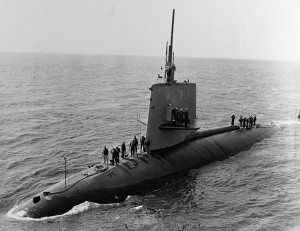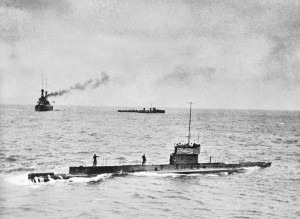Loss of the Scorpion
Tuesday, May 22nd, 2018May 22, 2018
Fifty years ago today, on May 22, 1968, the United States Navy nuclear submarine USS Scorpion (SSN-589) disappeared in the North Atlantic Ocean. USS stands for United States Ship. SSN designates a nuclear-powered attack submarine. Scorpion was returning home from operations in the Mediterranean Sea when the submarine lost all contact near the Azores, a group of islands about 800 miles (1,300 kilometers) west of Portugal. Five months after the submarine’s disappearance, Scorpion was found on the sea bottom some 10,000 feet (3,048 meters) below the ocean surface. All 99 crew members died on board. No official explanation for the loss of the submarine was ever made.

Crew members of USS Scorpion appear topside in Italian waters near the Bay of Naples in April 1968. The submarine was lost with all hands a month later. Credit: U.S. Naval History and Heritage Command
Scorpion was launched in 1959. In the early 1960′s, the submarine ran Navy patrols in European waters in conjunction with the North Atlantic Treaty Organization (NATO). Scorpion later participated in exercises along the Atlantic coast of the United States and in the Caribbean Sea. From February 1968 until May, the submarine patrolled and visited ports along the Mediterranean Sea. On May 21, while returning home, Scorpion reported a position about 50 miles (80 kilometers) south of the Azores. It was the submarine’s final communication. On May 27, Scorpion was reported overdue for its arrival at Norfolk, Virginia, and on June 5, the submarine was “presumed lost.”
Navy searches turned up nothing for several months. In late October 1968, the Navy oceanographic ship Mizar found Scorpion’s battered hull on the sea floor southwest of the Azores. The submarine’s location some 10,000 feet (3,048 meters) below the surface prevented salvage efforts and made the investigation a difficult one. Deep-sea submersibles took numerous photographs that showed significant damage to several parts of the submarine. Some of the damage could have been caused by an explosion, but the entire submarine was crushed as the submarine sank into the massive pressure of extreme sea depths. The maximum emergency dive range of the submarine was less than 1,500 feet (457 meters). No official explanation was ever made for the loss of Scorpion, but the Navy’s most likely theory was that an accidental detonation of a torpedo destroyed the submarine.
Scorpion was the second and last U.S. Navy nuclear submarine lost at sea. USS Thresher (SSN-593) was lost with 129 lives during a training exercise in 1963.



